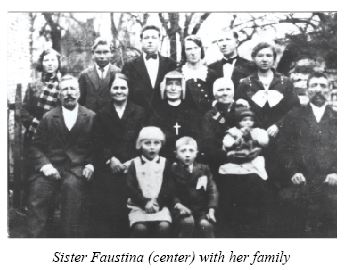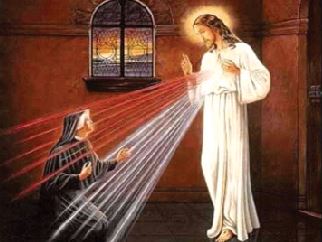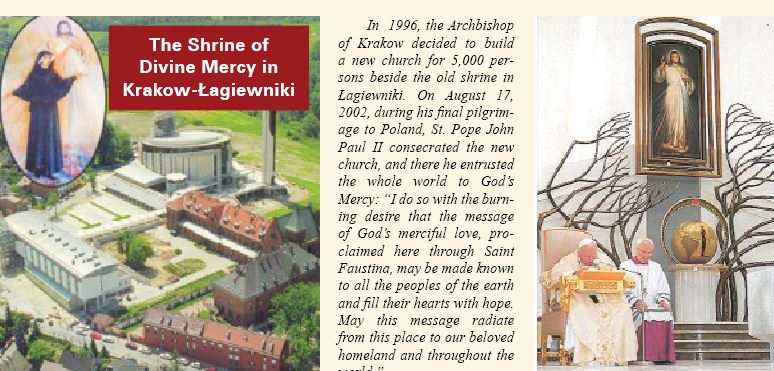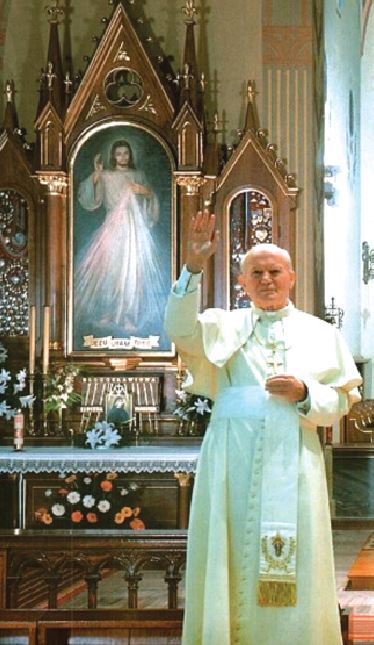by Dom Antoine-Marie, OSB
Confidence in God’s mercy is particularly necessary in our time, in a world which is noted for its scientific and technical successes, but which at the same time is marked by a profound moral crisis; this is made apparent in the questions of our contemporaries, addressed by Cardinal A. Rouco Verula, the Archbishop of Madrid, at the synod of European bishops:
“Apart from Jesus Christ, we do not know what God, life, death or ourselves truly are. It is not surprising that a culture without God ends in becoming as well a culture without hope, because only in Him, who is eternal and creative Love, does the heart of man find its origin and its true end.” (October 8, 1999.)
 A message for the world
A message for the worldJesus Christ wished to remind this world in distress of the love of His merciful Heart, through the voice of a modest, unknown woman who carried out the duties of cook, gardener, and doorkeeper in her convent. He addressed to her these words, at once astonishing and comforting: “I am sending you, with my Mercy, to all of humanity. I do not wish to punish suffering humanity, but I wish to cure it, to press it to my merciful Heart… Tell the whole world of my Mercy.” This humble nun, Sister Faustina Kowalska, was canonized on April 30, 2000, by Pope John Paul II.
Helena Kowalska, the third of ten children, was born on August 25, 1905, in Glogow, Poland. Lively, spontaneous, happy as a lark, Helena played like all the other children in the village. When she was seven, God called her by name: “For the first time,“ she would write later, “I heard distinctly the voice of God in my soul, inviting me to the perfect life. Yet I was not always obedient to Him” (Diary). At school, she distinguished herself by her intelligence. However, she was soon needed to help at home and, from the age of nine and a half, she exchanged her schoolbag for a shepherdess’ crook. At fourteen, Helena left to work on a neighboring farm. After a year of devoted service, showing herself pleasant and conscientious, she declared to her mother, “Mama, I want to become a nun!“ The reply was a categorical “no.” The Kowalska family could not afford the costs of setting up a dowry, which was necessary at that time to enter a convent. Helena returned to work, in the city of Lodz. When she turned 18, the young woman begged her parents again to allow her to realize her vocation. Her pleas were met with the same refusal.
“When my parents had forbidden me to enter the convent,” she wrote, “I tried to entertain myself with trifles, making the voice of grace fall on deaf ears… I avoided God and tended towards creatures. Yet grace triumphed. One day, I was at a ball with my sister. The gathering was in full swing, but my soul suffered from a strange uneasiness.
“When I began to dance, all of a sudden, I perceived Jesus next to me. Stripped, tortured, covered with wounds… He said to me, ‘How much longer will I endure you? Until when will you make me wait?’ Soon there was a great silence, and I no longer heard the music, and the joyous company vanished from my sight. There was no one but Jesus and me. I sat next to my sister, giving the excuse that I was suffering from a migraine.
“After a moment, I stole away from the ballroom and ran to the Cathedral of Saint Stanislas Kostka. The sun was beginning to rise, and there were only a few people there. Without worrying about those around me, I prostrated myself face to the ground before the Most Blessed Sacrament, and I asked what I should do now. I heard these words: ‘Go to Warsaw, there you will enter a convent.’ I got up immediately… put my affairs in order as I could… and, right away, with only a dress on my back and taking nothing with me, I took the train to Warsaw.”
 There, a little disoriented, she spoke to a priest who comforted her and placed her as a servant in the home of a very pious woman, until she would be received into the Congregation of Our Lady of Mercy. This Congregation, founded by Mother Thérèse Rondeau, (1793-1866), a Frenchwoman, helps women and young women who have fallen into a life of sin to return to the right path, and educates young women who need special protection to avoid the dangers of this world. In each convent, there are three categories of people: the directors, the coadjutors, and the boarders. Helena was admitted to the coadjutors, who take care of the material work of the house.
There, a little disoriented, she spoke to a priest who comforted her and placed her as a servant in the home of a very pious woman, until she would be received into the Congregation of Our Lady of Mercy. This Congregation, founded by Mother Thérèse Rondeau, (1793-1866), a Frenchwoman, helps women and young women who have fallen into a life of sin to return to the right path, and educates young women who need special protection to avoid the dangers of this world. In each convent, there are three categories of people: the directors, the coadjutors, and the boarders. Helena was admitted to the coadjutors, who take care of the material work of the house.
Happy at first, the postulant was soon disappointed—she was completely absorbed in manual labor and had but little time for prayer, meditation, private time with Jesus. “After three weeks,” she wrote, “I had decided to enter a stricter convent. This thought was so deeply anchored in my mind that one fine day I was quite resolved to leave… Returning to my cell, I prostrated myself face to the ground and begged God to show me His will… All of a sudden, there was a great light. On my curtain, I saw the Holy Face expressing an indescribable sorrow, covered with wounds and with huge tears which fell on my bedspread. Quite overcome, I said, ‘My Jesus, what is distressing You so?’ He replied, ‘You, if you leave: I have called you here, here I am preparing great graces for you’… From that day on, I felt happy and content.“ Appeased, Helena applied herself to living her ideal of union with God, with her pots and pans, digging in the garden, or selling bread in the coming and going of the gatehouse.
Allowed to take the habit on April 30, 1926, she took the name Sister Faustina. But soon a serious trial would begin for her: “From the end of my first year of novitiate, a darkness began to invade my soul, growing thicker and thicker,” she wrote. “My spirit became dark, the truths of the faith seemed absurd to me. When someone spoke to me of God, my heart was like a stone, incapable of the slightest act of love! I found no consolation in prayer… Often during the entire Mass, I did nothing but struggle with blasphemies that rushed to my lips… When the priest explained to me that these were trials and that, in this state, I was not offending God, but on the contrary, it was a sign that God loved me, I found no consolation in this—it seemed to me that these words were not for me…
 “I prostrated myself before the Blessed Sacrament and repeated these words: ‘Even if you kill me, I will have confidence in You!’” The acuteness of the trial, which lasted two and a half years, was equal to the mission which was to be entrusted to Sister Faustina. She who had to remind a world often in the pangs of agony, about confidence in the infinite Mercy, had known all the degrees of temptation to despair.
“I prostrated myself before the Blessed Sacrament and repeated these words: ‘Even if you kill me, I will have confidence in You!’” The acuteness of the trial, which lasted two and a half years, was equal to the mission which was to be entrusted to Sister Faustina. She who had to remind a world often in the pangs of agony, about confidence in the infinite Mercy, had known all the degrees of temptation to despair.
On February 22, 1931, Our Lord appeared to her, dressed in a magnificent white robe, one hand raised in a gesture of absolution and the other resting above His Divine Heart. From His robe, from which His Heart could be glimpsed, came two beams of light, one red and the other white. “In silence, I contemplated the Lord,” she wrote, “my soul was filled with fear, but also with great joy. After a moment, the Lord Jesus told me, ‘Paint an image according to this model and have it read: Jesus, I trust in You. I wish that this image be venerated first in your chapel, then throughout the world. I promise to those who will venerate it that they will not perish. I promise them victory over the enemy in this world, but especially at the hour of death. I will defend them myself, as my glory.’”
Sister Faustina confided in her confessor about this vision. The priest did not grant it much consideration. As the months went by, the orders from the Lord became clearer and more pressing: “I want priests to proclaim my most great Mercy. I wish for sinners to approach me without fear! The flames of my Mercy consume me. No sin, be it an abyss of abjection, will exhaust my Mercy, for the more it is drawn from, the more it grows. I came to this earth for sinners, and for them I have shed all my blood. I have all of eternity to punish; now, I am extending the time of Mercy. My Heart suffers, because even consecrated souls do not know my Mercy, and treat me with suspicion. How greatly the lack of trust wounds me!”
The news of Sister Faustina’s visions spread in the convent, and, although her life was exemplary, she was showered with opposition. “Everything was still bearable,” she wrote, “until the day when the Lord ordered me to paint His image. From this moment on, others began to regard me as a hysteric and someone suffering from hallucinations, and judgments rained heavily on me.” For two years, no priest dared give a definite opinion on these revelations. Finally, during her retreat before her perpetual profession, in April 1933, Fr. Joseph Andrasz, S.J., a spiritual man, told her, “My Sister, you mistrust the Lord Jesus because He treats you so intimately, don’t you think? Be calm. Jesus is your Master and your contacts with Him are nothing stemming from hysteria or dreams or illusion. Know that you are on the right path. Try to be faithful to the many graces you are receiving.” Immediately, Sister Faustina’s soul was filled with a deep, supernatural peace, and she was freed of her doubts.

The following May 1, she made her perpetual profession with great fervor. Four days later, she entered the chapel for a Holy Hour. “All of a sudden,” she wrote, “I saw the Lord, completely covered with wounds. He told me, ‘See whom you have wed’… I contemplated His wounds and I was happy to suffer with Him. O my God, how sweet it is to suffer for You, from the depths of our hearts, unbeknown to anyone… Thank you, Jesus, for the little daily crosses, for the annoyances and sufferings of community life, for the false interpretations of my plans, for the humiliations and poor treatment, for the painful suspicions, for my ruined health and my extreme weariness… Thank you, Jesus, for the suffering in my soul, for the periods of dryness, the anxiety and uncertainty, for the night and the interior darkness, for the temptations and trials… Thank you, Jesus, You who have drunk this bitter cup before offering it to me sweetened. I desire nothing but what You wish, according to the plans of Your Eternal Wisdom.”
At the end of May 1933, Sister Faustina left for Wilno. There, she met Father Sopocko (who was beatified in 2008), who became her spiritual director. After considerable hesitation, he decided to have the image of the merciful Jesus painted, but he wanted to know the meaning of the white and red rays beaming from the Lord’s Heart. Sister Faustina asked the Divine Master, who replied, “They symbolize water and blood, the water which gives souls justification, and the blood which is the life of the soul. They flow from my heart opened on the Cross. These rays shelter the soul from my Father’s anger,” in other words, from the punishment merited by our sins. The Sunday after Easter 1935, the icon was publicly exposed in the sanctuary of Our Lady of Ostra Brama, and soon, the Divine Mercy was manifested by many graces of extraordinary conversions.
 In her Diary, Sister Faustina wrote, “Mercy is the greatest of the divine attributes.” Father Sopocko, initially perplexed, discovered this truth in the works of St. Augustine and Saint Thomas Aquinas. Indeed, no attribute of God is stressed as strongly in the Bible as Mercy. God is not a distant being, indifferent to man’s destiny, but He is the Friend, the Savior, the Good Shepherd, in whose eyes each person is precious. After man’s fall through original sin, this fall which had so many tragic consequences (suffering, death…), God fully revealed His Mercy to us in the mysteries of the Incarnation and the Redemption. All of Christ’s life on earth, His words and actions, His parables and His miracles, His death on the Cross and His Resurrection, the foundation of His Church, guided through the centuries by the Holy Spirit, proclaim God’s Mercy to the whole world.
In her Diary, Sister Faustina wrote, “Mercy is the greatest of the divine attributes.” Father Sopocko, initially perplexed, discovered this truth in the works of St. Augustine and Saint Thomas Aquinas. Indeed, no attribute of God is stressed as strongly in the Bible as Mercy. God is not a distant being, indifferent to man’s destiny, but He is the Friend, the Savior, the Good Shepherd, in whose eyes each person is precious. After man’s fall through original sin, this fall which had so many tragic consequences (suffering, death…), God fully revealed His Mercy to us in the mysteries of the Incarnation and the Redemption. All of Christ’s life on earth, His words and actions, His parables and His miracles, His death on the Cross and His Resurrection, the foundation of His Church, guided through the centuries by the Holy Spirit, proclaim God’s Mercy to the whole world.
To be merciful is to have a heart moved to sadness at the sight of another’s misfortune as if it were our own, and to try, as much as possible, to remove or relieve it. The greatest ill which affects man is sin. God cures it through His Mercy. Insofar as it offends God, sin effects unfathomable harm, whose eternal consequence was shown to Sister Faustina. “I, Sister Faustina, by God’s command, penetrated the abysses of Hell to speak to souls about it and give witness that Hell exists.” Another vision exposed men’s sins to Sister Faustina: “In the blink of an eye,” she noted on February 9, 1937, “the Lord showed me the sins committed in the world today. I fainted from terror! Although I know the depths of fathomless Mercy, I was completely astonished that God permits the world to exist! Then I heard from Him that the chosen ones counterbalance it.”
But no matter the number and the seriousness of sins, God’s Mercy is always ready on earth. “I am Holy,” Jesus told Sister Faustina, “and the least sin horrifies me. But when sinners repent, my Mercy is limitless… The greatest sinners could become the greatest saints if they trusted in my Mercy… My Mercy is drawn from only with the cup of confidence. The greater one’s confidence, the greater the Mercy obtained… I am overjoyed when sinners turn to my Mercy. I fill them beyond their hopes.” On October 10, 1937, our Saint wrote, “I saw, in a great light, the abyss of my nothingness. And I nestled in the Heart of Jesus with such confidence that even if I bore on my conscience all the sins of the damned, I would not doubt in the Divine Mercy, but I would hurl myself, with a contrite heart, in the abyss of Your love, Lord Jesus! I know that You would not reject me, but that You would forgive me through Your priest.” Divine Mercy is given to sinners principally through confession. “In this sacrament,”» wrote St. Pope John Paul II, “each (baptized) person can experience Mercy in a unique way, that is, the love which is more powerful than sin» (Encyclical Dives in Misericordia, November 30, 1980, no. 13).

A powerful cause for hope, the Divine Mercy is also a call to conversion. Without sincere repentance for one’s sins and a firm resolve to mend one’s ways, Mercy cannot be poured out on the sinner. “On the part of man, only a lack of good will can limit (Mercy), a lack of readiness to be converted and to repent, in other words persistence in obstinacy, opposing grace and truth, especially in the face of the witness of the cross and resurrection of Christ” (Dives in Misericordia, no. 13). Saint Alphonsus of Liguori notes that God’s Mercy extends towards those who fear Him (cf. Lk. 1: 50), in other words, “the Lord applies Mercy towards those who fear offending Him, but not towards those who count on His Mercy in order to further offend Him” (The Way of Salvation, Part 1, 8th meditation).
 St. John Paul II at the Shrine of Divine Mercy in Krakow-Łagiewniki on June 7, 1997, in front of the tomb of Sister Faustina and the image of the Merciful Jesus St. John Paul II at the Shrine of Divine Mercy in Krakow-Łagiewniki on June 7, 1997, in front of the tomb of Sister Faustina and the image of the Merciful Jesus |
If, thanks to Christ’s Passion, the Divine Mercy provides the supreme cure for sin, the greatest of evils which affect man, it also extends to all the other forms of suffering, physical or moral, which touch him. Sometimes, it does away with them; but more often, it manifests itself in its proper and true aspect “when it draws good from all the forms of evil existing in the world and in man” (Dives in Misericordia, no. 6). Therein is found the fundamental meaning of Jesus Christ’s messianic message, whose mission reveals the “proof of the love which does not allow itself to be conquered by evil, but overcomes evil with good (cf. Rom. 12: 21)” (Ibid, no. 6). In order to overcome evil, God’s Mercy gives to all who invoke it strength and patience in trial, teaching them to unite their sufferings to those of the Divine Crucified. “This consoling message (of Mercy) is addressed above all to those who (are) afflicted by a particularly harsh trial,” says St. Pope John Paul II. “To them the gentle face of Christ is offered; those rays from His heart touch them and shine upon them, warm them, show them the way and fill them with hope. How many souls have been consoled by the prayer ‘Jesus, I trust in You’” (Homily of the Mass of Canonization).
God’s mercy also arouses true brotherly love between individuals. “It is not easy to love with a deep love, which lies in the authentic gift of self,” St. Pope John Paul II maintained. “This love can only be learned by penetrating the mystery of God’s love. Looking at Him, being one with His fatherly heart, we are able to look with new eyes at our brothers and sisters, with an attitude of unselfishness and solidarity, of generosity and forgiveness. All this is mercy!” (Ibid.). Jesus exhorts His disciples to place themselves “in the school of God,” so as to obtain for themselves the Divine Mercy. Blessed are they who show mercy; mercy shall be theirs (Mt. 5: 7).
Until the end of her life, Sister Faustina performed works of Mercy towards her neighbors. She had suffered, since 1933, from tuberculosis. Her Superiors did not realize at first the seriousness of this illness, which she endured in silence. In December 1936, when the illness was already in an advanced stage, she was sent to a sanitarium. She remained there four months, then, in 1938, was sent there again for five months.
She prayed fervently for the suffering people in her midst, whose conversion she often obtained, even in humanly desperate circumstances. She recited the “Chaplet of Divine Mercy” for their intentions, a devotion which was revealed to her on September 14, 1935. (See page 24.) Returning to the convent in September 1938, Sister Faustina went peacefully to her eternal rest at the age of 33, on October 5 of that year.
In a beautiful prayer, Sister Faustina reveals her manner of practicing Mercy. (See the Prayer of the Missionary of Mercy on page 48.)
Let us ask the Most Blessed Virgin, Mother of Mercy, and Saint Joseph to teach us to be merciful like our Father in Heaven, so as to obtain His Mercy and eternal life.
Dom Antoine Marie, OSB

This article is reprinted with permission from the Abbey of Clairval, France, which every month publishes a spiritual newsletter on the life of a saint, in English, French, Italian, or Dutch. Their postal address: Dom Antoine Marie, Abbe, Abbaye Saint-Joseph de Clairval 21150 Flavigny sur Ozerain, France. Their website: http:// www.clairval.com.